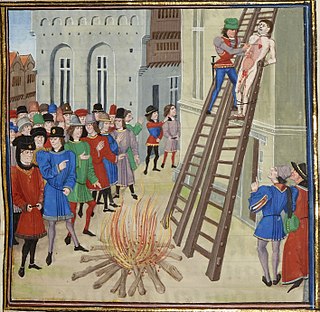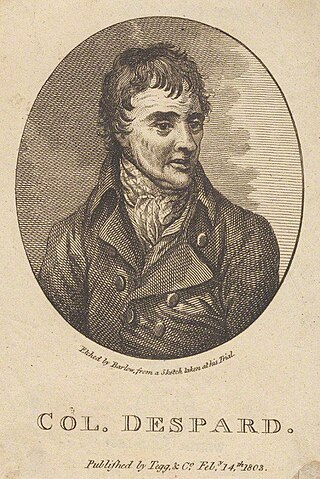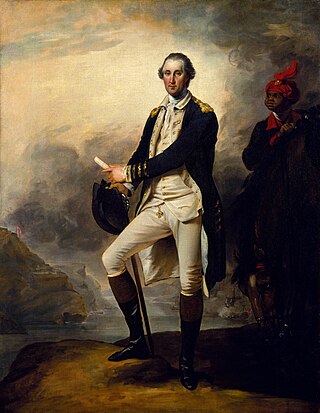
Edward Law, 1st Baron Ellenborough,, was an English judge. After serving as a member of parliament and Attorney General, he became Lord Chief Justice.

Bridewell Palace in London was built as a residence of King Henry VIII and was one of his homes early in his reign for eight years. Given to the City of London Corporation by his son King Edward VI for use as an orphanage and place of correction for wayward women, Bridewell later became the first prison/poorhouse to have an appointed doctor.

Sir Francis Burdett, 5th Baronet was a British politician and Member of Parliament who gained notoriety as a proponent of universal male suffrage, equal electoral districts, vote by ballot, and annual parliaments. His commitment to reform resulted in legal proceedings and brief confinement to the Tower of London. In his later years he appeared reconciled to the very limited provisions of the 1832 Reform Act. He was the godfather of Francisco Burdett O'Connor, one of the famed Libertadores of the Spanish American wars of independence.

Edward Marcus Despard, an Irish officer in the service of the British Crown, gained notoriety as a colonial administrator for refusing to recognise racial distinctions in law and, following his recall to London, as a republican conspirator. Despard's associations with the London Corresponding Society, the United Irishmen and United Britons led to his trial and execution in 1803 as the alleged ringleader of a plot to assassinate the King.

Baylis Road is a thoroughfare in Lambeth, London SE1, England running between Westminster Bridge Road to the South-West and Waterloo Road to the North-East.
Horsemonger Lane Gaol was a prison close to present-day Newington Causeway in Southwark, south London. Built at the end of the 18th century, it was in use until 1878.

Victoria is an area of Central London in the City of Westminster. It is named after Victoria Station, which is a major transport hub. The station was named after the nearby Victoria Street.
Events from the year 1803 in the United Kingdom.

Coldbath Fields Prison, also formerly known as the Middlesex House of Correction and Clerkenwell Gaol and informally known as the Steel, was a prison in the Mount Pleasant area of Clerkenwell, London. Founded in the reign of James I (1603–1625) it was completely rebuilt in 1794 and extended in 1850. It housed prisoners on short sentences of up to two years. Blocks emerged to segregate felons, misdemeanants and vagrants.

The house of correction was a type of establishment built after the passing of the Elizabethan Poor Law (1601), places where those who were "unwilling to work", including vagrants and beggars, were set to work. The building of houses of correction came after the passing of an amendment to the Elizabethan Poor Law. However the houses of correction were not considered a part of the Elizabethan Poor Law system because the Act distinguished between settled poor and wandering poor.
Middlesex House of Correction may refer to one of several institutions:

To be hanged, drawn and quartered became a statutory penalty for men convicted of high treason in the Kingdom of England from 1352 under King Edward III (1327–1377), although similar rituals are recorded during the reign of King Henry III (1216–1272). The convicted traitor was fastened to a hurdle, or wooden panel, and drawn by horse to the place of execution, where he was then hanged, emasculated, disembowelled, beheaded, and quartered. His remains would then often be displayed in prominent places across the country, such as London Bridge, to serve as a warning of the fate of traitors. For reasons of public decency, women convicted of high treason were instead burned at the stake.

Clerkenwell (old) Prison, also known as the Clerkenwell House of Detention or Middlesex House of Detention was a prison in Clerkenwell, London, opened in 1847 and demolished in 1890. It held prisoners awaiting trial.
Peter Finnerty was an Irish printer, publisher, and journalist in both Dublin and London associated with radical, reform and democratic causes. In Dublin, he was a committed United Irishman, but was imprisoned in the course of the 1798 rebellion. In London he was a campaigning reporter for The Morning Chronicle, imprisoned again in 1811 for libel in his condemnation of Lord Castlereagh.
The Devizes County House of Corrections or Devizes Prison was a correctional facility in Devizes, Wiltshire, England. It opened in 1817, replacing the Old Bridewell prison, and fell out of use after around a hundred years. For a time it was the only prison in Wiltshire.

The Despard Plot was a failed 1802 conspiracy by British revolutionaries led by Colonel Edward Marcus Despard, a former army officer and colonial official. Evidence presented in court suggested that Despard planned to assassinate the monarch George III and seize key strong points in London such as the Bank of England and Tower of London as a prelude to a wider uprising by the population of the city. The British Government was aware of the plot five months before the scheduled date of attack, but waited to arrest to gain enough evidence. One week before the scheduled attack, Despard and his co-conspirators were arrested at the Oakley Arms pub in Lambeth on suspicion of plotting an uprising. Despard's execution on 21 February 1803 was attended by a crowd of around 20,000, the largest public gathering until the funeral of Lord Nelson two years later following the Battle of Trafalgar.

The Clerkenwell explosion, also known as the Clerkenwell Outrage, was a bombing in London on 13 December 1867. The Irish Republican Brotherhood, nicknamed the "Fenians", exploded a bomb to try to free one of their members being held on remand at Clerkenwell Prison. The explosion damaged nearby houses, killed 12 people and caused 120 injuries. None of the prisoners escaped. The event was described by The Times the following day as "a crime of unexampled atrocity", and compared to the "infernal machines" used in Paris in 1800 and 1835 and the Gunpowder Treason of 1605. The bombing was later described as the most infamous action carried out by the Fenians in Britain in the 19th century. It enraged the public, causing a backlash of hostility in Britain which undermined efforts to establish home rule or independence for Ireland.
John Courtenay was an Irish officer in the British Army who became a politician in England. He was a Whig member of Parliament (MP) at Westminster from 1780 to 1807, and again in 1812.

George Washington, also entitled George Washington and William Lee, is a full-length portrait in oil painted in 1780 by the American artist John Trumbull during the American Revolutionary War. General George Washington stands near his enslaved servant William Lee, overlooking the Hudson River in New York, with West Point and ships in the background. Trumbull, who once served as an aide-de-camp to Washington, painted the picture from memory while studying under Benjamin West in London. He finished it before his arrest for high treason in November. The portrait, measuring 36 in × 28 in, is on view in Gallery 753 at the Metropolitan Museum of Art in New York City. Originally in the possession of the de Neufville family of the Netherlands, it was bequeathed to the museum by Charles Allen Munn in 1924.
Catherine Despard, from Jamaica, publicised political detentions and prison conditions in London where her Irish husband, Colonel Edward Despard, was repeatedly incarcerated for their shared democratic convictions. Her extensive lobbying failed to save him from the gallows when, in 1803, he was tried and convicted for a plot to assassinate King George III.















